Ankle Compression Socks vs Knee High: Which is Better?
Written By Alecsa Stewart
Scientifically Reviewed by Daniel Chantigian
The research on compression socks by scientists has found that there are many benefits for circulation, muscle recovery and repair, and overall well being. Compression socks can also help prevent leg health problems. While there is medical evidence that proves compression socks can be beneficial for your health, there are still questions around how to choose your pair, especially because there are many varieties. One commonly asked question about compression socks is:
-
Should you wear ankle-high or knee-high compression socks?
The main difference between ankle and knee-high socks is obviously their length and the part of the leg covered. This impacts their effectiveness to an extent, but there is not a black-and-white answer as to which you should choose. In this article, we analyze the key differences and outline where and when you would use each type of socks.
Do Ankle Compression Socks Work?
Although knee-high compression socks are the standard when it comes to boosting blood flow and supporting joints and muscles, ankle socks might provide a lot of the same benefits, but research on ankle high compression socks is limited. All lengths of compression socks support good circulation for the area they cover. Moreover, a study has shown no difference between knee-high and thigh-high compression stockings when it comes to reducing pain and edema among nurses.
It’s simply important to remember that ankle socks apply therapeutic pressure from the ankle down, stimulating the blood flow out of the feet and ankles, but not the lower leg. They also support the ankle and massage the foot and ankle area. Knee-length socks extend these benefits to the calf muscles and shins. Support from compression garments is particularly beneficial to those returning to activity after an injury. Wearing compression socks is known to increase balance and stability and reduce the effects of micro-vibrations (aka landing impact) on your joints and muscles.
Clinical research also shows that wearing compression socks helps prevent blood clots and deep vein thrombosis. This is critical for when you take long-haul flights or must sit or stand for long periods of time, which can cause blood to pool at the lower end of your body and lead to blood clots forming.
Are Ankle Compression Socks Effective for Improving Circulation?
Yes, because ankle compression socks work the same as other compression socks, they can stimulate blood flow out of the feet and ankles and towards the heart. This prevents blood and other fluids from pooling in the feet and ankles. This contributes to the healthy circulation of blood throughout the body, as well as to lymphatic drainage. Moreover, the way that ankle socks massage and support the ankles and feet may also help bring down inflammation to reduce swelling and discomfort.

Browse stylish compression socks for everyday wear.
Ankle Compression Socks vs Knee High Compression Socks
Depending on your priorities, you may choose knee-high compression socks to boost circulation and support the muscles or stick with ankle-high socks. Here are some key ways in which these garments differ.
Stability and Support
Both knee-high and ankle compression socks apply therapeutic pressure to the lower limbs, providing support and stability, as well as relief from aches and pains. When you wear knee-high socks, the feeling of tightness and slight massage will continue up the leg to just under your knees. With ankle socks, this only applies to the foot and ankle joint.
Some research has analyzed the effects of wearing knee-high compression socks on proprioception (the perception of our position and body movements). That research found that compression can improve proprioception to reduce balance problems in older adults. It may reduce the risk of falls. Better balance with compression socks occurs because wearing compressive and textured materials can cause receptors in the skin and joints to activate more effectively, which can enhance feedback from the skin and joints. This positive effect might be caused by ankle socks, too.
Circulation and Swelling
Both ankle and knee-high compression socks stimulate blood flow through the therapeutic pressure on the lower leg veins. For knee-high socks, they act on the leg veins up to the knee, which gives them more effectiveness in preventing blood clots and deep vein thrombosis (which tends to form in the deep leg veins, not the feet).
Ankle socks, on the other hand, boost blood flow in the feet and just below the ankle bone. They, therefore, have a smaller area of effectiveness, but the benefit of pushing blood from the feet to the circulatory system will also have an impact on the lower legs and even the rest of the body.
An added benefit of wearing knee-high compression socks, rather than ankle-height, is that they are graduated. This means they apply more pressure in the foot and ankle area, gradually releasing it as the sock climbs up the leg. The result of this is better upward blood flow and a reduced risk of swelling or blood clots. Ankle socks simply do not have the surface area to have as much of an impact.

Try graduated compression socks to prevent blood clots when traveling
Muscle Recovery
Compression in general is known to reduce the time it takes athletes to recover after exercise - whether that’s professionals or simply recreational runners, hikers, etc. This is thanks to the improvement in blood flow, which brings with it oxygen and nutrients critical to muscle repair and growth. In fact, one study found that compression can enhance recovery for damaged muscles.
With this in mind, wearing knee-high compression socks helps reduce soreness and improves recovery speed for your lower legs (e.g., the calf muscles, tendons, and ligaments). Ankle socks can offer similar benefits, but are reduced to the feet and ankles only, since they don’t go up the leg high enough to encompass the Achilles tendon, the calves, or the tibial bone.
Travel and Sitting
Both ankle and knee-high compression socks stimulate blood flow in the lower legs, preventing the blood and lymph fluid from pooling around the ankles. This means that, if you are stuck on a long-haul flight or sitting at your desk for long hours, you can reduce the risk of swelling and discomfort. You also reduce the risk of developing deep vein thrombosis by wearing these garments.
Sports and Exercise
There has been research into the performance enhancing benefits of compression, but studies are not unanimous. We know that there is better circulation when athletes wear compression garments, which reduces swelling and discomfort. Knee-high compression socks can also help reduce some of the micro-vibrations that go through muscles and joints when we jump or land repeatedly on hard surfaces (running, playing tennis, etc.).
Ankle compression socks boost circulation and will offer some extra support to the arch of the foot, too. This can relieve foot pain and prevent injuries, while also helping with recovery from plantar fasciitis.
Everyday Wear
All the above benefits combine to make compression socks great for everyday wear, particularly if you are an active person wanting to improve their energy and recovery, or if you have circulatory problems and want to maintain a healthy blood flow.
One added difference here is that knee-high compression socks also bring a spot of color and style to your everyday outfits. Our Vim & Vigr range gives you lots of different designs to choose from, elevating day-to-day wardrobes to help you stand out. Ankle socks, unfortunately, are too short to make a style statement.

Brighten up your outfits with functional & stylish compression socks.
What Are Ankle Compression Socks Used For?
Compression socks that go up to just above the ankle are great for boosting circulation in your feet and for supporting the ankle joint. Here are some of the best use cases for ankle-height compression socks:
-
Increasing blood flow to the feet, especially for those with circulatory problems (be sure to discuss this with your doctor)
-
Reduce swelling and pain in the ankles and feet
-
Relieving soreness in the ankles and feet
-
Supporting the ankle joint after surgery or when recovering from injuries
-
Preventing blood clots and vein-related injuries and damage
-
Keeping feet warm thanks to increased blood flow
What are Knee-High Compression Socks Used For?
Knee-high compression socks provide all the benefits listed for ankle socks, but they also support the calf muscles and the veins in your lower legs. This area between your ankle and your knee is under a lot of pressure when playing sports, running, walking, or hiking. It is also a part of our bodies where we often develop blood clots, varicose veins, or deep vein thrombosis.
To help prevent soreness, swelling, and medical conditions, knee-high compression socks stimulate circulation and prevent blood from pooling in the lower extremities during exercise or even when you are at work sitting for long periods of time. They also massage and gently support the calf muscles (along with the feet and ankles), which improves the recovery process after exercise. After a long day on your feet (working, walking, or standing), knee-high compression socks are a great way to get relief and prepare for going out again the next day.
You can use knee-high compression socks to:
-
Increase blood flow in the lower legs below the knee
-
Support and speed up recovery for the calf muscles after vigorous exercise
-
Support the lower legs during walking, hiking, running, or standing
-
Prevent the formation of blood clots and other medical conditions in the lower legs
-
Prevent or reduce swelling and aches and pains below the knees
How to Choose the Right Option for You
For lifestyle and athletic needs, compression socks are great for preventing swelling, improving recovery, and keeping you fresh and energized during travel or at work. For those suffering from certain medical conditions, compression socks support better blood flow and help prevent leg health issues and also reduce the impacts of certain illnesses (like lymphedema or varicose veins). Here is how to choose whether ankle or knee-high socks are the best for your situation.
Compression Needs and Goals
Start with identifying your needs. It may be helpful to ask yourself: what do you want to wear compression socks for and what part of your legs or feet is affected?
If you are looking for an overall boost in blood flow, reduced swelling, and better energy levels, knee-high compression socks give you better coverage and have scientifically proven effectiveness. They are also better for sports and exercise, since they help support the entire lower leg and then deliver blood quicker to the muscles, enhancing recovery.
If, however, you want to prioritize compression in the foot, to support your arches or to improve circulation specifically below the ankle, then you would choose ankle socks. Ankle socks may also be appropriate for recovery from ankle surgery, depending on your doctor’s advice.
Lifestyle
Compression socks are not just functional, they can be fun and stylish, too! The Vim& Vigr range of everyday compression socks can enhance your looks and offer a pop of color while still delivering all of the essential benefits of compression. Depending on your individual style, however, you may be happier choosing black stockings or compression leggings.
If your lifestyle involves a lot of standing around or sitting for long periods of time in trains or planes, you may want to consider ankle-high socks to prevent your ankles from swelling up. However, runners and hikers will opt for knee-high socks to get more benefits higher up the leg.
Doctor Recommendations
You should always consult with a medical professional if you have a circulatory problem or health condition. They will be able to suggest the specific type of compression socks for you and advise on compression levels, too.
If you are suffering from pain or discomfort due to blood clots or varicose veins, knee-high compression will be the most effective. Your doctor can also prescribe stronger levels of compression; in case the need arises.
–
Making the choice between ankle and knee-high compression socks is not just a matter of aesthetics. While you can get important circulatory benefits and support from ankle socks, there is more to gain from wearing knee-high compression socks that extend blood flow stimulation to below the knee. You will also have better support and receive a soothing massage to the calf muscles. Plus, let’s not forget the style points!

Browse our stylish compression wear collection
References
Amaragiri, S. V., & Lees, T. A. (2000). Elastic compression stockings for prevention of deep vein thrombosis. The Cochrane database of systematic reviews, (3), CD001484. Read it here.
Baige, K., Noé, F., Bru, N., & Paillard, T. (2020). Effects of Compression Garments on Balance Control in Young Healthy Active Subjects: A Hierarchical Cluster Analysis. Frontiers in human neuroscience, 14, 582514. Read it here.
Charles, T., Mackintosh, D., Healy, B., Perrin, K., Weatherall, M., & Beasley, R. (2011). Merino wool graduated compression stocking increases lower limb venous blood flow: a randomized controlled trial. Advances in therapy, 28(3), 227–237. Read it here.
Engel, F. A., Holmberg, H. C., & Sperlich, B. (2016). Is There Evidence that Runners can Benefit from Wearing Compression Clothing?. Sports medicine (Auckland, N.Z.), 46(12), 1939–1952. Read it here.
Hill, J., Howatson, G., van Someren, K., Leeder, J., & Pedlar, C. (2014). Compression garments and recovery from exercise-induced muscle damage: a meta-analysis. British journal of sports medicine, 48(18), 1340–1346. Read it here.
Lee, Y., Kim, K., Kang, S., Kim, J. Y., Kim, S. G., Kim, T., & Jung, J. (2020). Compression Stocking Length Effects on Oedema, Pain, and Satisfaction in Nursing Students: A Pilot Randomized Trial. Healthcare (Basel, Switzerland), 8(2), 149. Read it here.
Lim, C. S., & Davies, A. H. (2014). Graduated compression stockings. CMAJ: Canadian Medical Association journal = journal de l'Association medicale canadienne, 186(10), E391–Read it here.
Montoye, A. H. K., Mithen, A. A., Westra, H. L., Besteman, S. S., & Rider, B. C. (2021). The Effect of Compression Socks on Maximal Exercise Performance and Recovery in Insufficiently Active Adults. International journal of exercise science, 14(7), 1036–1051. Read it here.
Partsch, H., Winiger, J., & Lun, B. (2004). Compression stockings reduce occupational leg swelling. Dermatologic surgery: official publication for American Society for Dermatologic Surgery [et al.], 30(5), 737–743. Read it here.
Woo, M. T., Davids, K., Chow, J. Y., & Jaakkola, T. (2021). Acute effects of wearing compression knee-length socks on ankle joint position sense in community-dwelling older adults. PloS one, 16(2), e0245979. Read it here.







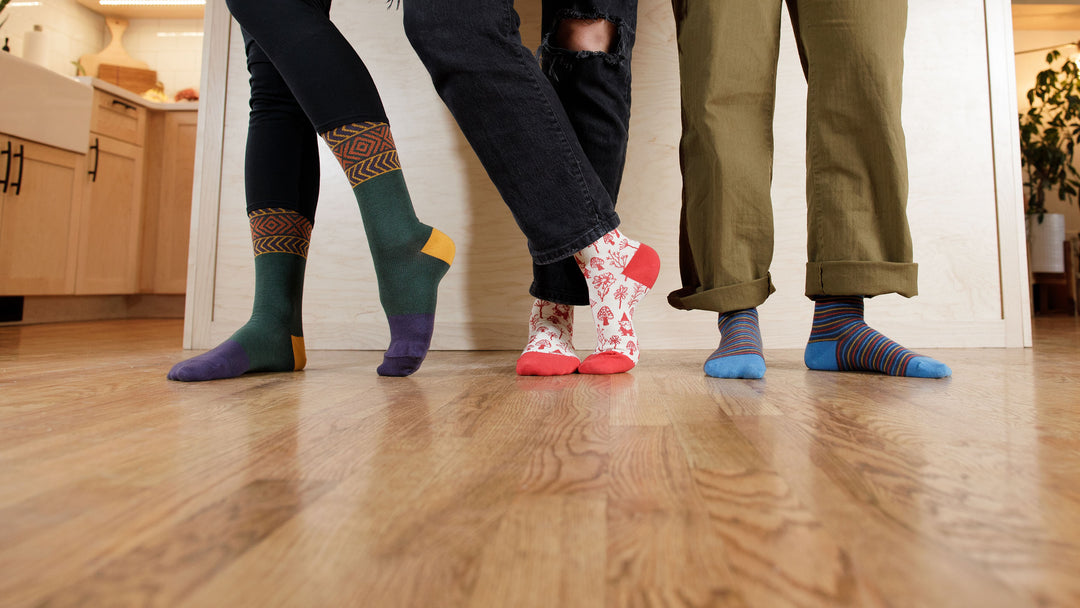

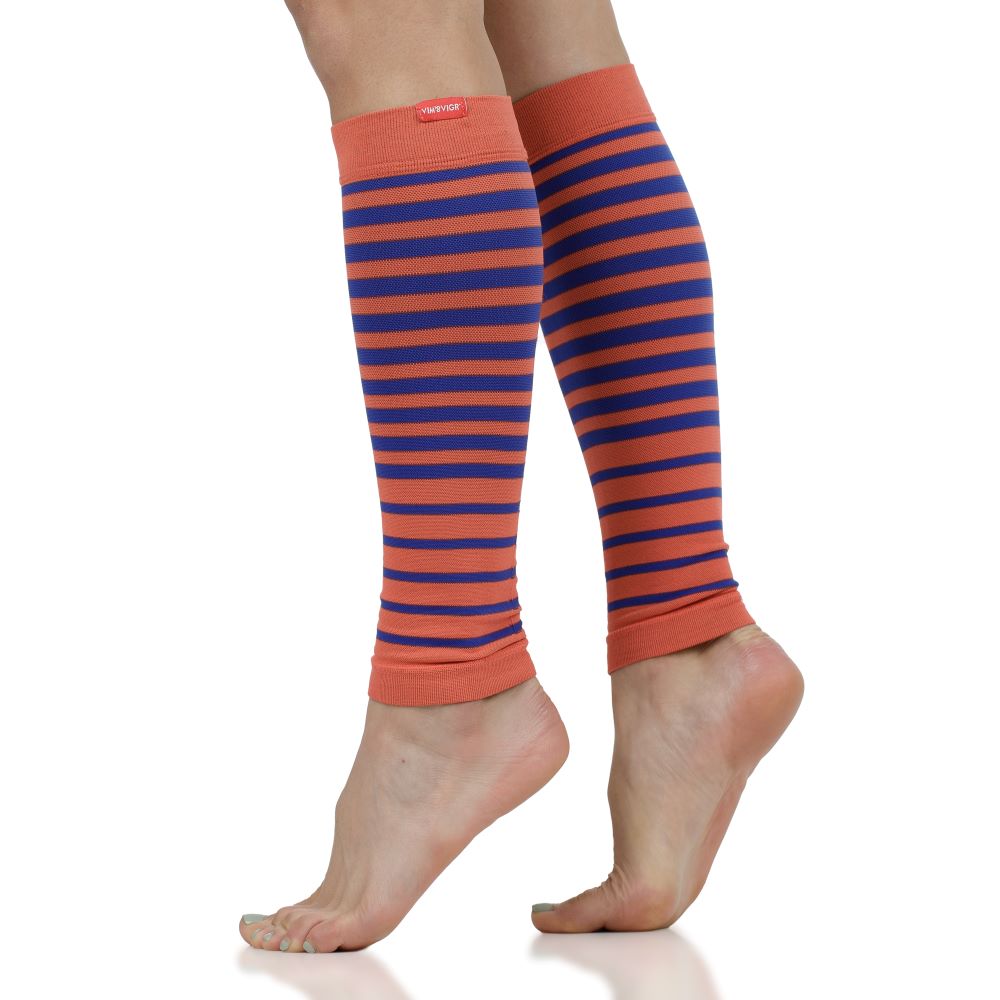
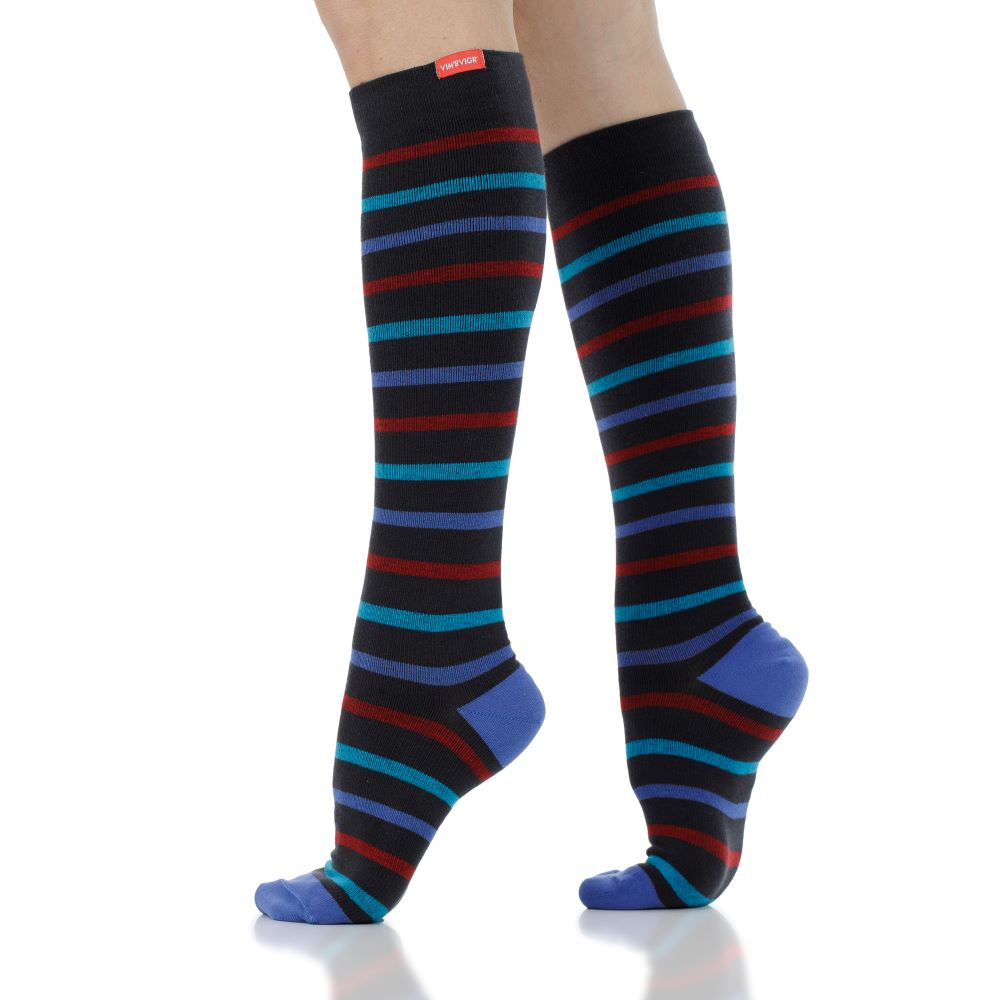
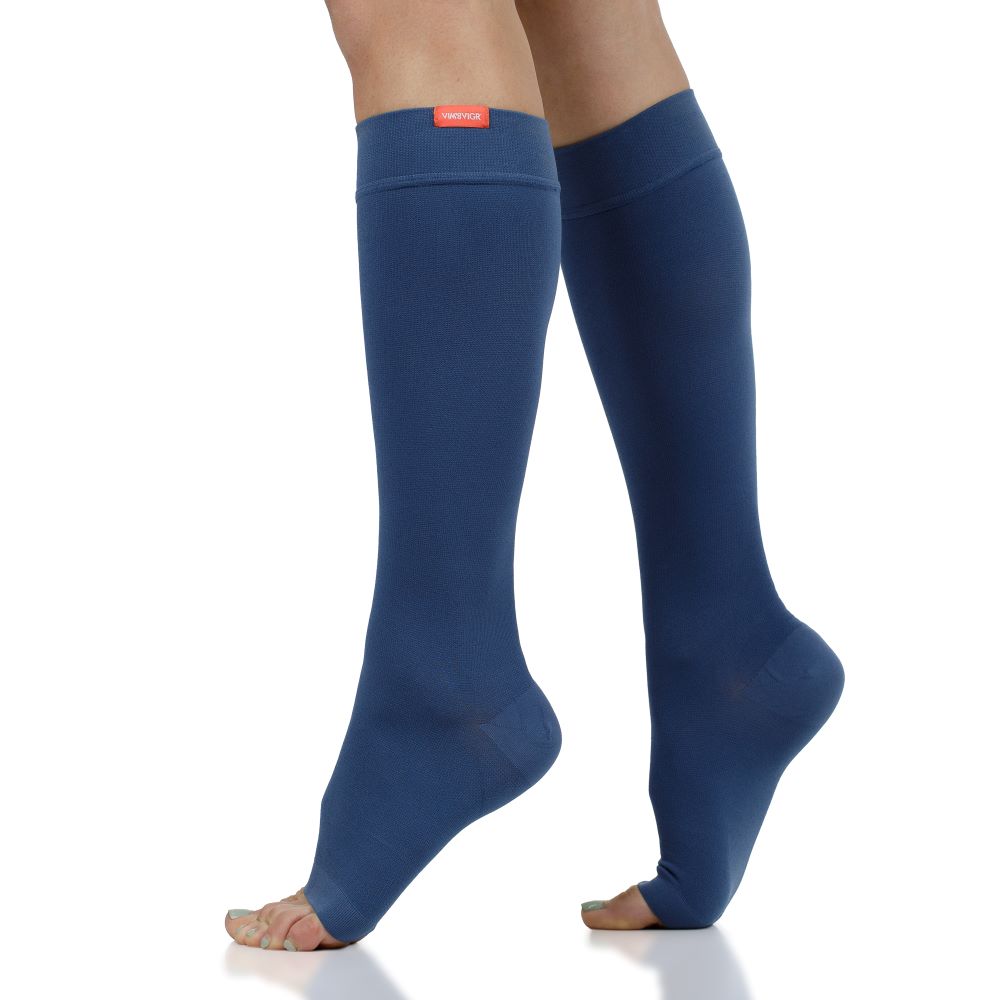




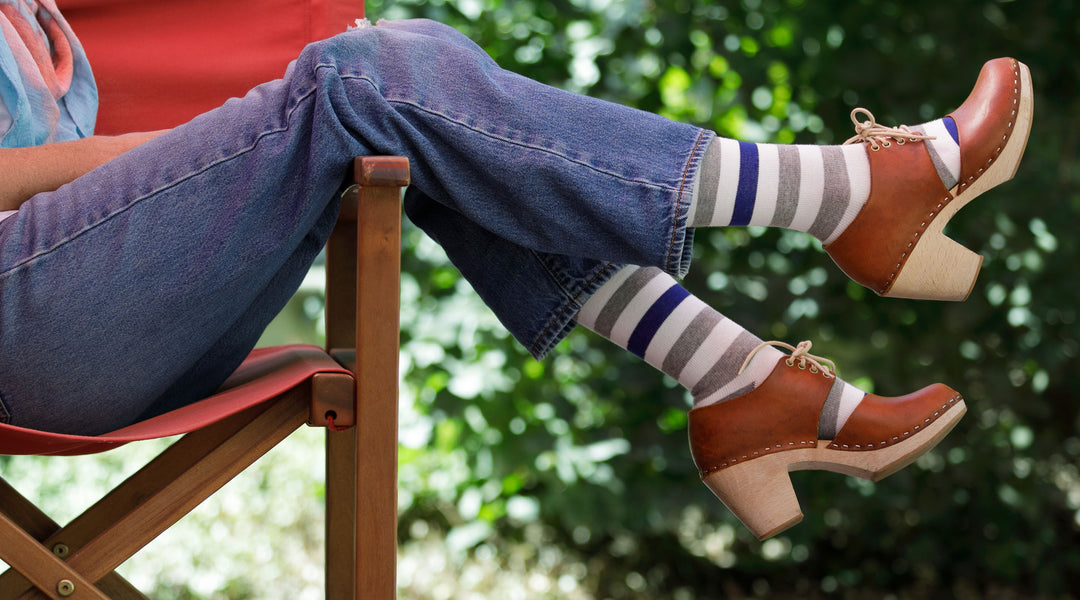

Thank you for this informative article. I wasn’t sure whether I needed ankle-high or knee-high compression socks, but you cleared it up me! I was right to buy the ankle-high. Happy about that choice!
Leave a comment